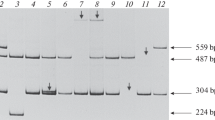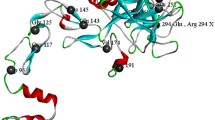Abstract
Hemophilia A (HA) is an inherited X-linked bleeding disorder caused by a variety of mutations that are distributed throughout the large FVIII gene (F8). The most common mutations in studied populations with severe HA are introns 22 and 1 inversions, gross exon deletions and point mutations in exon 14. The aim of this study was to define the frequency of these common mutations in Iranian population of Azeri Turkish in North West of Iran. Fifty patients with severe HA and forty-three female potential carriers were genotyped by inverse shifting polymerase chain reaction (IS-PCR), long-range PCR, multiplex PCR, and sequencing methods for the detection of Intron 22 and 1 inversions, gross exon deletions, and exon 14 point mutations, respectively. F8 intron 22 inversion was detected in 22 (44 %) out of 50 patients. Moreover, we detected one intron 1 inversion (2 %), and one point mutation in exon 14 (2 %). In this population, 52 % of the patients with hemophilia A did not show to carry a mutation in the analyzed regions by three mentioned methods. F8 intron 22 inversion was the major causative mutation in nearly 50 % of severe HA cases in an Azerbaijani Turkish population, which is similar to the incidence of other populations. IS-PCR is a robust, rapid, efficient, and cost-effective method for the genetic analysis of patients with severe HA and for HA carrier detection, especially in developing countries.

Similar content being viewed by others
References
Hoyer LW (1994) Hemophilia A. N Engl J Med 330(1):38–47
Oldenburg J, Ananyeva N, Saenko E (2004) Molecular basis of haemophilia A. Haemophilia 10(s4):133–139
Liu Q, Nozari G, Sommer SS (1998) Single-tube polymerase chain reaction for rapid diagnosis of the inversion hotspot of mutation in hemophilia A. Blood 92(4):1458–1459
Antonarakis SE, Rossiter J, Young M et al (1995) Factor VIII gene inversions in severe hemophilia A: results of an international consortium study. Blood 86(6):2206–2212
Rossiter JP, Young M, Kimberland M et al (1994) Factor VIII gene inversions causing severe hemophilia A originate almost exclusively in male germ cells. Hum Mol Genet 3(7):1035–1039
Cumming A (2004) The factor VIII gene intron 1 inversion mutation: prevalence in severe hemophilia A patients in the UK. J Thromb Haemost 2(1):205–206
Lakich D, Kazazian HH, Antonarakis SE et al (1993) Inversions disrupting the factor VIII gene are a common cause of severe haemophilia A. Nat Genet 5(3):236–241
Bagnall R, Giannelli F, Green P (2006) Int22h-related inversions causing hemophilia A: a novel insight into their origin and a new more discriminant PCR test for their detection. J Thromb Haemost 4(3):591–598
Rossetti LC, Radic CP, Abelleyro MM et al (2011) Eighteen years of molecular genotyping the hemophilia inversion hotspot: from southern blot to inverse shifting-PCR. Int J Mol Sci 12(10):7271–7285
Rossetti L, Radic C, Larripa I et al (2008) Developing a new generation of tests for genotyping hemophilia-causative rearrangements involving int2h and int1h hotspots in the factor VIII gene. J Thromb Haemost 6(5):830–836
Miller S, Dykes D, Polesky H (1988) A simple salting out procedure for extracting DNA from human nucleated cells. Nucleic Acids Res 16(3):1215
Rossetti LC, Radic CP, Larripa IB et al (2005) Genotyping the hemophilia inversion hotspot by use of inverse PCR. Clin Chem 51(7):1154–1158
Bagnall RD, Waseem N, Green PM et al (2002) Recurrent inversion breaking intron 1 of the factor VIII gene is a frequent cause of severe hemophilia A. Blood 99(1):168–174
Hwang S, Kim M, Lim J et al (2009) Profiling of factor VIII mutations in Korean haemophilia A. Haemophilia 15(6):1311–1317
Andrikovics H, Klein I, Bors A et al (2003) Analysis of large structural changes of the factor VIII gene, involving intron 1 and 22, in severe hemophilia A. Haematologica 88(7):778–784
Zimmermann M, Oldenburg J, Müller C et al (2011) Unusual genomic rearrangements in introns 1 and 22 of the FVIII gene. Hämostaseologie 31(Suppl 1):S69–S73
Tizzano E, Domenech M, Altisent C et al (1994) Inversions in the factor VIII gene in Spanish hemophilia A patients (letter). Blood 83(12):3826
Acquila M, Pasino M, Lanza T et al (2003) Frequency of factor VIII intron 1 inversion in a cohort of severe hemophilia A Italian patients. Haematologica 88(5):ELT17
Brasi D (2000) Intron 22 factor VIII gene inversions in Argentine families with severe haemophilia A. Haemophilia 6(1):21–22
Rossetti LC, Candela M, Bianco RP et al (2004) Analysis of factor VIII gene intron 1 inversion in Argentinian families with severe haemophilia A and a review of the literature. Blood Coagul Fibrinolysis 15(7):569–572
Ahmed R, Kannan M, Choudhry VP et al (2003) Mutation reports: intron 1 and 22 inversions in Indian haemophilics. Ann Hematol 82(9):546–547
Abou-Elew H, Ahmed H, Raslan H et al (2011) Genotyping of intron 22-related rearrangements of FVIII by inverse-shifting PCR in Egyptian hemophilia A patients. Ann Hematol 90(5):579–584
Roozafzay N, Kokabee L, Zeinali S et al (2013) Evaluation of intron 22 and intron 1 inversions of the factor 8 gene using an inverse shifting PCR method in severe haemophilia A patients. Sci Asia 39(2):174–178
Mantilla-Capacho JM, Beltran-Miranda CP, Luna-Zaizar H et al (2007) Frequency of intron 1 and 22 inversions of factor VIII gene in Mexican patients with severe hemophilia A. Am J Hematol 82(4):283–287
Salazar-Sánchez L, Jiménez-Cruz G, Mendez M et al (2010) Molecular analysis of FVIII gene in severe HA patients of Costa Rica. Hämostaseologie 30(1):S150–S152
Riccardi F, Tagliaferri A, Manotti C et al (2002) Intron 1 factor VIII gene inversion in a population of Italian hemophilia A patients. Blood J 100:3432
Habart D, Kalabova D, Hrachovinova I et al (2003) Significant prevalence of the intron 1 factor VIII gene inversion among patients with severe hemophilia A in the Czech Republic. J Thromb Haemost 1(6):1323–1324
Santacroce R, Acquila M, Belvini D et al (2008) Identification of 217 unreported mutations in the FVIII gene in a group of 1,410 unselected Italian patients with hemophilia A. J Hum Genet 53(3):275–284
Ljung R, Kling S, Sjörin E et al (1991) More than half the sporadic cases of hemophilia A in Sweden are due to a recent mutation. Acta Paediatr 80(3):343–348
Acknowledgments
We extend our sincere thanks to all participating families with HA for their contributions to this study. This study was supported by grants from the Hematology and Oncology Research Center, Tabriz University of Medical Sciences, Tabriz, Iran.
Author information
Authors and Affiliations
Corresponding author
Rights and permissions
About this article
Cite this article
Shekari Khaniani, M., Ebrahimi, A., Daraei, S. et al. Genotyping of Intron Inversions and Point Mutations in Exon 14 of the FVIII Gene in Iranian Azeri Turkish Families with Hemophilia A. Indian J Hematol Blood Transfus 32, 475–480 (2016). https://doi.org/10.1007/s12288-016-0699-2
Received:
Accepted:
Published:
Issue Date:
DOI: https://doi.org/10.1007/s12288-016-0699-2




